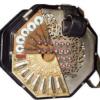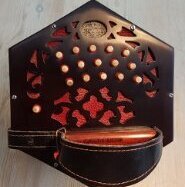-
Posts
1,868 -
Joined
-
Last visited
About d.elliott
- Birthday 08/08/1950
Contact Methods
-
Website URL
http://www.concertina-repair.org.uk
Profile Information
-
Gender
Male
-
Interests
ENGLISH System: including: Bass; Baritone; Treble; Miniature, some Anglo
All forms of Concertina playing, but also Repair and Restoration of traditional instruments (all systems). like to provide help & assistance as needed. Author of 'Concertina Maintenance Manual'
I give talks and run workshops on repair and restoration
West Gallery Singing & Shape Note Singing
Traditional Music, Concertina Band Playing -
Location
Oughtibridge, Sheffield, South Yorkshire, England
Recent Profile Visitors
d.elliott's Achievements

Heavyweight Boxer (5/6)
-

How urgent are leaky bellows?
d.elliott replied to Vitlich's topic in Instrument Construction & Repair
Be warned, using self adhesive tape, or 'rubbery' glues will contaminate the leather causing further glue failures and leaving a residue that can preclude any future repairs. -

EC tuning mystery solved....I think
d.elliott replied to Matthew Heumann's topic in Instrument Construction & Repair
Down tuning the low G# to F nat. gives the root note to the key of F (one flat on the key signature). If you are playing in 'flat' keys then retaining the low Ab in it's original position makes sense. All my playing menagerie from G Bass to treble have this configuration, all but one from original manufacture. For this modification I use low temperature solder, also easy to reverse. -

English thumb strap tightness dilemma
d.elliott replied to DeafIdiotGod's topic in General Concertina Discussion
Better that the straps are a little loose so you can slide the thumb forward and back to reach the higher keys on the keyboards. -

How urgent are leaky bellows?
d.elliott replied to Vitlich's topic in Instrument Construction & Repair
In reality bellows are a consumable item, like pads, valves etc. they just have a longer life. The best way of dealing with corner splits on the top skives is to re-bind them, corner patches are OK, but can come off. -
The issue is not distortion of the reeds, it is the effect of gravity on the leather flap valves. If you want consistent performance and some degree of longevity from the valves then the instrument must be stored with the bellows axis horizontal. This will ensure that the reedpans ae vertical and hence the valves are not likely to be curled by gravity. The hexagonal cases were progressively superseded by square cases that kept the bellows compressed and the concertina axis horizontal.
-
Lachenal Baritone English and a Baritone Anglo and a Treble Anglo, but not all played at the same time.
-

Looking for Wheatstone/Lachenal 26 button Anglo layout
d.elliott replied to Lefty52's topic in General Concertina Discussion
-

Choosing between small Maccanns
d.elliott replied to Bouleaux's topic in General Concertina Discussion
Lowering a reed by three semitones, even by weighting the tip will depend on the strength of the reed body and the size of the chamber. You cannot take it for granted that the reed will remain responsive and/ or loud enough to be effective. Worth a try, but don't be surprised if the outcome is a bit less than optimal. -

Holding bellows shut for display
d.elliott replied to Leah Velleman's topic in General Concertina Discussion
The reason for holding the bellows closed is that when you are playing phrases, especially with chords, you can play the bellows stroke almost to closed before you get noticeable changes in resistance from the bellows. For the same reason you should, from time to time, (with some keys depressed) stretch the bellows out fully. You need to maximise the free movement of the bellows to give you the best shot at playing through phrases. A bit like a singer doing breathing exercises. -

My new free reeds instruments
d.elliott replied to Valentin Nourdin's topic in General Concertina Discussion
Valentin, If you get stuck, and you want advice then email me, or phone. I am glad you bought my book. -
Wheatstones' are/ were English Made, and 'Anglo' is 'English' the name taken from the Angels or as the Romans called the tribe Angli . The etymology of the name of English Counties and the Anglo-Saxons. Although I doubt the Wheatstone Designer was thinking historically. Makes more sense than calling Anglos 'Irish' concertinas?
-
A wise decision, we are more or less contemporaries and I really understand your motivation.
-

Bursary for Folkworks Durham Summer School
d.elliott replied to Roger Gawley's topic in General Concertina Discussion
My daughter attended over a number of years, it brought along her musicianship, her confidence and helped her with a network of contacts. I can strongly recommend the Folk Works youth summer school.- 1 reply
-
- 1
-

-

Interesting notes on "Old Pitch" in concertinas
d.elliott replied to Matthew Heumann's topic in General Concertina Discussion
The 'descendant company ' that made the tuning forks is still in existence in Sheffield. -

Troubleshooting leaky action box
d.elliott replied to RogerT's topic in Instrument Construction & Repair
Hope it works for you.








